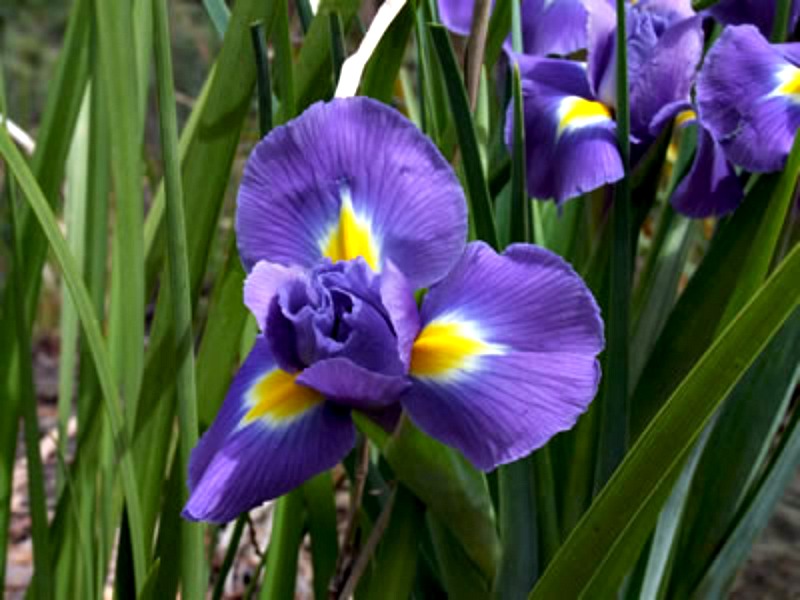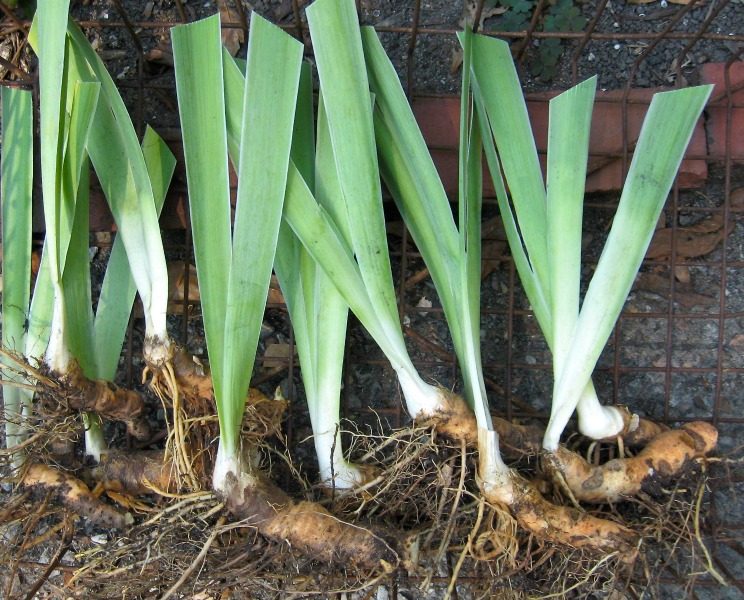Bearded irises can be beautiful!

Bearded Iris
Irises multiply fairly quickly and when they become overcrowded they produce fewer blooms. To ensure abundant flowers on your irises, the plants should be divided every three to four years.
The best time to divide and transplant irises is two to three weeks after they’re done blooming for the season, through the end of August.
This is how you divide them:
The roots are known as rhizomes. Dig them out, wash with plain water and inspect them. Keep only the young healthy rhizomes. Discard any that are shriveled or have holes in them, or any that
are soft and mushy.

Rhizomes
Before replanting the iris leaves should be cut back to about six inches.
To replant the healthy rhizomes, dig a shallow hole with your trowel and set each rhizome in the hole about 8 inches apart, carefully spreading out the roots on each rhizome. Add a granular bulb
fertilizer to the hole at this time to keep your irises happy.
Irises will bloom poorly or not at all if the rhizomes are planted too deeply. They should be barely covered with soil. The upper surface of the rhizomes should be at the soil level.
Get ready for an explosion of extravagant flowers next spring.
Have a great week!
-Mike McGroarty
Mike thanks for your wonderful resources, I have subscribed and downloaded or watched several of your videos/ebooks. I am searching for plants that do well with wet feet or river bottom soil. We are here in Houston Texas and have 20 acres in the floodway that I believe we could make into a backyard nursery – with the right plants or trees being our focus.
I would love the benefit of your advice on which plants or trees you think will grow well here, in good draining soil but low and prone to flooding. We have black soil here, not clay, and tons of run-off of top soil from upstream. Our ground water is at about 30-40 feet in the “bottoms” and we rarely freeze here. Summers are hot – often in the 100’s for at least 1 month, sometimes two. Humidity here is often 100% when not raining – “wet blanket” environment. We can build shelters as needed.
I am looking forward to becoming a member, but first I wanted to find out if my idea is at all feasible for where I can plant and my climate and its downsides. I need help to identify the plants/trees I can make work here to build my business.
Lonna,
Keep in mind, most nurseries grow in containers and very little in the ground. So no matter your soil you can do this. The best place to get this questioned answered is from our members, http://backyardgrowers.com/join, who know far more about plants for your climate than I do. But the simple answer is that whatever they are selling in garden centers in your area, that’s what you should start out growing. Your soil sounds amazing but the big question is how wet is it and for how long does it stay wet or flooded.
Dear Mike,
Not meaning to quibble but isn’t that Iris siberica in the photo, not Iris germanica?? The photo of the rhizomes looks like I germanica though!
Waiting for it to cool down here in Central Texas, sigh.
Julie
Julie,
I don’t know. This is an article that I did not write, it was written by one of our subscribers. You might be right.
Your correct Julie, the photo is of a siberian.
Peter Berry
New Zealand
I’m learning so much on your site! Love it! I have a TON of irises at our home from the previous owner, but they are getting crowded and my dad wants a few, so this post is perfect. Thanks!
I was talking to friends in church yesterday when one of the men told me about Mike’s Backyard Nursery site. Talk about a small world!!! When he told me this nursery is in Perry, OH (we now live in Silver Creek, GA), I almost fell out of my pew!! Our family lived in Madison, OH from 1973 – 1981. I remember going to the assorted nurseries in Perry for our flowers. How long has your nursery been open and where exactly are you located.
I can remember my uncle telling my family when I was very young — “Perry, OH has the best soil in Ohio. You can plant almost anything there and it will grow!!” That is so true — I now miss that black rich soil compared to the hard red dirt we have here in GA!!!!!
Carol,
I’ve only been in my current location for five years. Before that I was on Middle Ridge Road in Perry. Now I’m on north ridge road, right down the road from Secor’s Nursery. My address is 4850 North Ridge Road.
Bill and I,live in Meridian. TX. We tried to locate your nursery a year ago on our
extended vacation to Nova Scotia, couldn’t find you but we did see a lot of pretty
back roads and had lunch at a small pub with good eating. Glad to get your
address. Try care and wonderful gardening, I am a yard person living on 56 acre
Bosque county farm, rocks, cactus, mesquites, live oaks and cedars that surround us. Beginning of the “Hill Country” in TX. Do so much enjoy your website; hoping we go North again this year. So much to learn and soooo little time. Blessings to you and yours. Kathy
Just a friendly note. No questions. just lotz of reading
Kathy,
The address of my nursery is 4850 North Ridge Road, Perry, Ohio 44081 [email protected]